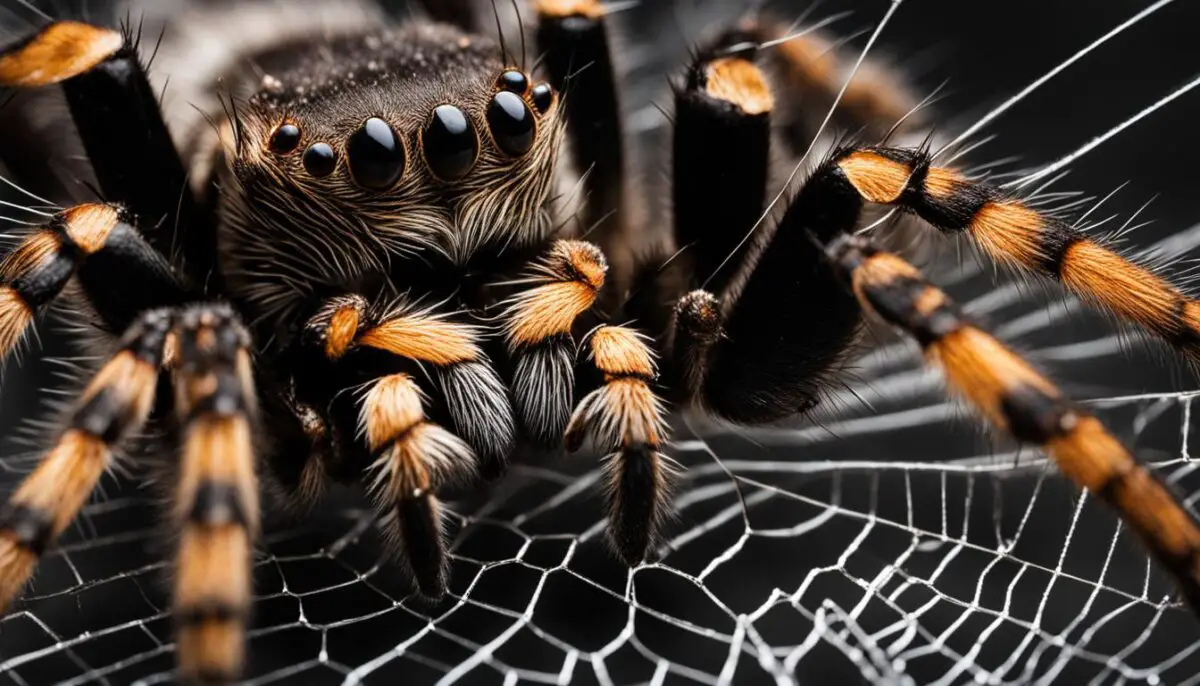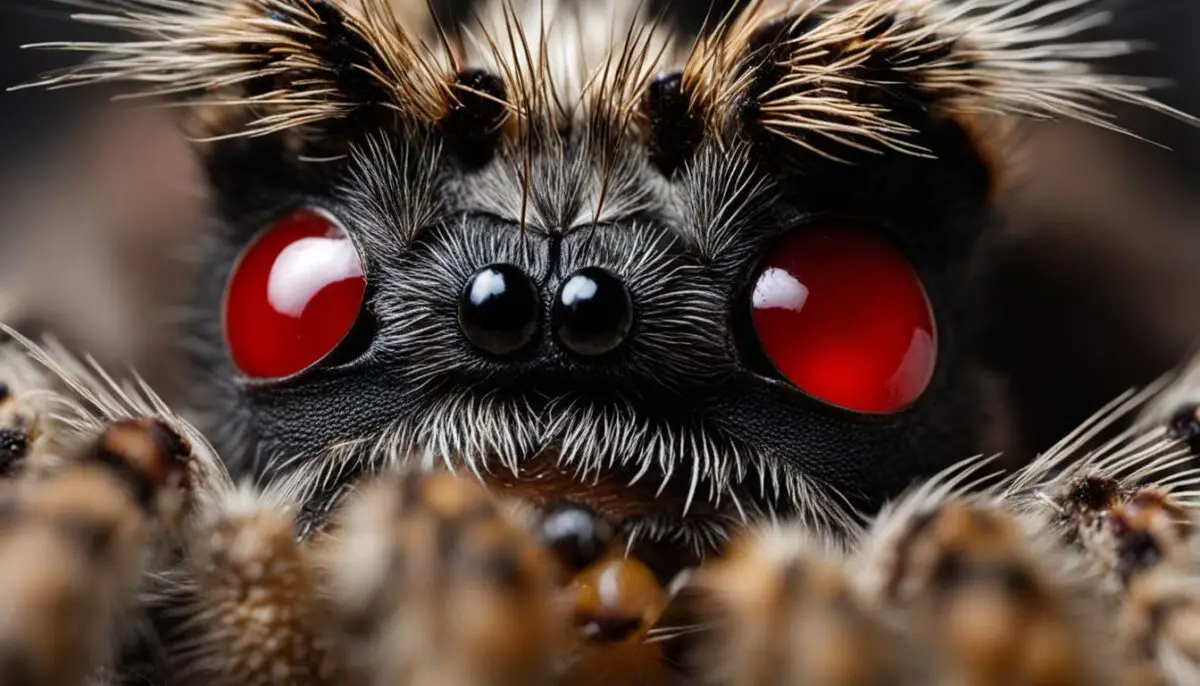Tarantulas, the large and intriguing spiders of the family Theraphosidae, have captivated human curiosity for centuries. They are known for their impressive size, diverse colors, and enigmatic behaviors. With over 900 documented species worldwide, tarantulas display a remarkable range of adaptations that enable them to thrive in various ecosystems.
One distinguishing characteristic is their impressive lifespan, which can extend up to several decades in some species. Their eyes play a crucial role in their survival, aiding in navigation, hunting, and predator detection. Tarantulas possess a fascinating variety of eyes, each serving a specific purpose in their visual perception. Understanding the different types of tarantula eyes sheds light on the complexity of their vision system.
Key Takeaways:
- Tarantulas are large and diverse spiders known for their impressive size, colors, and behaviors.
- They have over 900 documented species and display remarkable adaptations that enable them to thrive in various ecosystems.
- Tarantulas have a fascinating variety of eyes, each serving a specific purpose in their visual perception.
- Understanding tarantula eye structure and function sheds light on their complex vision system.
- Their eyes play a crucial role in navigation, hunting, and predator detection.
What Tarantulas Look Like
Tarantula Eyes: The Key to Survival and Adaptation
Tarantulas, with their impressive size and diverse colors, have captured the fascination of humans for centuries. But it is their eyes that truly make them remarkable creatures. The role of tarantula eyes in their survival and adaptation to various environments cannot be underestimated. These unique arachnids have evolved a sophisticated vision system that enables them to navigate their surroundings, hunt for prey, and avoid potential threats. what tarantulas look like
Among the most notable adaptations of tarantula eyes is their ability to excel in low-light conditions. Many tarantula species are nocturnal hunters, relying on their eyesight to detect movement and track prey. Their eyes are equipped with a combination of primary and secondary lenses, which allow for a wide field of vision and depth perception. This enables them to accurately capture their prey, even in the darkness of night. tarantula appearance
Furthermore, tarantula eyes have intricate structures that optimize their visual perception. Transparent lenses focus light onto the retina, while a reflective layer called the tapetum enhances sensitivity and light-gathering ability in dimly lit environments. This combination of features allows tarantulas to see in near-darkness and adapt to changing light conditions with ease. tarantula physical characteristics
The Importance of Visual Perception in Tarantula Hunting
“Tarantula eyes play a vital role in their hunting and survival strategies. Their keen vision helps them locate and capture prey by accurately perceiving their movements. By visually tracking their prey, tarantulas can plan and execute precise strikes. Additionally, their wide field of vision and acute sensitivity to motion allow them to identify potential threats, such as predators, and respond quickly to avoid danger.”
Overall, the complexity and adaptability of tarantula eyes contribute greatly to their ability to survive and thrive. These fascinating creatures have finely tuned visual systems that allow them to navigate their environment, hunt efficiently, and ensure their own safety. Understanding the intricacies of tarantula eyes provides valuable insights into their fascinating world and highlights the remarkable adaptations that have made them successful predators. tarantula characteristics
Tarantula Eye Structure and Function
Understanding the structure and function of tarantula eyes provides insight into their remarkable visual capabilities. Tarantula eyes consist of multiple layers and specialized adaptations that optimize their visual perception. The eyes have transparent lenses that focus light onto the retina, located at the back of each eye. These lenses minimize optical aberrations and maintain clarity in visual perception. tarantula features
One fascinating feature of tarantula eyes is the presence of a reflective layer called the tapetum. Acting like a mirror, the tapetum reflects light back through the retina, increasing sensitivity in low-light conditions. This adaptation allows tarantulas to thrive in various lighting environments, including dimly lit areas. Their eyes can rapidly adapt to changing light conditions, enabling them to see clearly in both bright and dark settings. tarantula identification
Tarantulas possess a variety of photoreceptors in their eyes, which are highly sensitive to light. These photoreceptors enable tarantulas to detect even the faintest traces of light, making them adept nocturnal hunters. The combination of large primary eyes and the reflective tapetum amplifies the limited available light, allowing tarantulas to navigate and hunt in near-darkness. tarantula visual traits
To summarize, tarantula eyes have a complex structure with lenses, a tapetum, and specialized photoreceptors that enhance their visual perception. This remarkable adaptation enables tarantulas to excel in low-light conditions and provides them with a competitive advantage in hunting and survival.

Table 1: Comparison of Tarantula Eye Structure and Function
| Eyes | Structure | Function |
|---|---|---|
| Main Eyes (Anterior Median Eyes) | Transparent lenses, tapetum | Primary visual organs, forward-facing view, movement detection, color differentiation, depth perception |
| Secondary Eyes (Anterior Lateral Eyes) | Transparent lenses | Contribute to overall visual perception |
| Additional Eyes | Varies by species | Enhanced visual awareness and comprehensive environmental view |
Main Types of Tarantula Eyes
Tarantulas, with their fascinating visual perception, possess a variety of eyes that contribute to their ability to navigate and thrive in their environments. Let’s explore the main types of tarantula eyes, each serving a specific purpose in their visual perception: identifying tarantula species
- Main Eyes (Anterior Median Eyes): These are the primary visual organs of tarantulas, providing a forward-facing view. They play a crucial role in detecting movement, distinguishing colors, and assessing depth. The main eyes allow tarantulas to accurately perceive their surroundings and locate potential prey or mates.
- Secondary Eyes (Anterior Lateral Eyes): Tarantulas also have secondary eyes located on the sides of their cephalothorax. These eyes contribute to overall visual perception and provide a wider field of vision, allowing tarantulas to monitor their surroundings effectively. tarantula body structure
- Additional Eyes: Some tarantula species possess additional eyes, which vary in number and location depending on the species. While the exact functions of these additional eyes are still being studied, they likely contribute to the tarantula’s overall visual awareness, providing a more comprehensive view of their environment.
With their combination of main and secondary eyes, tarantulas have developed a visual system that allows them to perceive their surroundings accurately, detect movement, and navigate their environment with precision.
Table: Comparison of Tarantula Eye Types
Let’s compare the main types of tarantula eyes in terms of location and their specific functions:
| Main Eyes (Anterior Median Eyes) | Secondary Eyes (Anterior Lateral Eyes) | Additional Eyes |
|---|---|---|
| Located facing forward | Located on the sides of the cephalothorax | Varies in number and location |
| Primary visual organs | Contributes to overall vision | Contributes to overall vision |
| Detect movement, distinguish colors, assess depth | Wider field of vision | Enhances visual awareness |
By understanding the different types of tarantula eyes and their specific functions, we can gain a deeper appreciation for the complex visual system that allows these fascinating creatures to thrive in their diverse habitats.
Tarantula Vision in Low-Light Conditions
Tarantulas, being predominantly nocturnal creatures, have developed an impressive ability to see in low-light conditions. Their vision is specially adapted to excel in dimly lit environments, allowing them to navigate and hunt effectively under the cover of darkness. One key aspect of their low-light vision is their exceptional light sensitivity. Tarantulas possess highly sensitive photoreceptor cells in their eyes that can detect even the faintest traces of light, enabling them to perceive movement and discern objects in near-darkness.
This heightened light sensitivity is further enhanced by the presence of a reflective layer in their eyes, known as the tapetum. The tapetum acts like a mirror, reflecting light back through the retina and increasing the available light for the photoreceptor cells. This adaptation improves their vision in low-light conditions, allowing tarantulas to spot potential prey and avoid threats more effectively.
The combination of their large primary eyes and the tapetum enables tarantulas to maximize the limited available light, providing them with a significant advantage when hunting and surviving in their dark, nocturnal habitats.
| Feature | Description |
|---|---|
| Light Sensitivity | Tarantulas have highly sensitive photoreceptor cells that can detect even faint traces of light. |
| Tapetum | A reflective layer in their eyes that acts like a mirror, reflecting light back through the retina and increasing available light for the photoreceptor cells. |
| Large Primary Eyes | Tarantulas’ primary eyes are larger than their secondary eyes, allowing for better light-gathering capabilities. |
With these adaptations, tarantulas can effectively navigate and thrive in the darkness, utilizing their well-developed low-light vision to hunt for prey and avoid potential predators. Their ability to see in near-darkness showcases the remarkable adaptations and survival strategies that have evolved in these fascinating arachnids.
Tarantula Color Vision: Unveiling the Dichromatic Perception
Tarantulas, with their unique visual system, possess a dichromatic color vision. While humans perceive a wide spectrum of colors, tarantulas are limited to two primary channels: green and ultraviolet (UV). This specialized color perception allows them to detect certain colors that stand out in their environment, aiding in prey identification and potential mate recognition. Though their color vision may not be as rich as ours, tarantulas excel at detecting contrasts in brightness and texture, providing them with a distinctive advantage in their hunting strategies.
“Tarantulas have adapted to perceive colors that are most relevant to their survival,” explains Dr. Arachnologist Maria Rodriguez. “Their dichromatic vision allows them to quickly spot potential prey that may be camouflaged or blending in with their surroundings. This enhanced contrast detection enables them to accurately locate and capture their next meal.”
Contrary to popular belief, tarantulas’ color vision is not solely dependent on their eyes. The hairs covering their bodies also play a significant role in their color perception. These sensory hairs, known as setae, are sensitive to light and help tarantulas distinguish different shades and intensities of colors, providing supplementary information to their visual perception.
The Role of Color Vision in Tarantula Behavior
Color vision in tarantulas plays a crucial role in their behavioral patterns. It aids in identifying prey, evaluating potential mates, and recognizing territorial boundaries. For example, some tarantula species have been observed to exhibit specific color displays during courtship rituals, using vibrant hues to attract potential mates. Similarly, certain warning coloration or patterns on their bodies can serve as a deterrent to predators, signaling toxicity or aggressive behavior.
“Understanding tarantulas’ color perception allows us to gain insights into their ecological interactions,” says Dr. Rodriguez. “Their ability to detect colors and contrasts not only affects their hunting success but also influences their social behavior and mating strategies.”
Further research is needed to unveil the intricacies of color vision in tarantulas and how it has influenced their evolution and ecological role. By unraveling the mysteries behind tarantula color perception, scientists can continue to deepen our understanding of these fascinating creatures and their place in the natural world.
| Insights on Tarantula Color Vision | Key Findings |
|---|---|
| Color Perception | Tarantulas have dichromatic color vision, perceiving colors in the green and ultraviolet (UV) spectrum. |
| Contrast Detection | Tarantulas excel at detecting contrasts in brightness and texture, allowing them to locate and capture prey with precision. |
| Behavioral Significance | Color vision plays a role in tarantula courtship rituals, prey identification, and predator deterrence. |
| Sensory Hairs | Tarantulas’ setae, or sensory hairs, also contribute to their color perception and enhance their ability to differentiate shades. |
 Tarantulas’ superior prey detection abilities are a result of their visual acuity. Their primary and secondary eyes work together to detect movement and track potential meals. By accurately perceiving prey movements, tarantulas can strategically position themselves for a successful hunt. The combination of their wide field of vision and sharp eyesight allows them to spot even the smallest movements, giving them an advantage in capturing their prey. This visual prowess is an integral part of their hunting strategy, ensuring their survival in their diverse habitats.
Tarantulas’ superior prey detection abilities are a result of their visual acuity. Their primary and secondary eyes work together to detect movement and track potential meals. By accurately perceiving prey movements, tarantulas can strategically position themselves for a successful hunt. The combination of their wide field of vision and sharp eyesight allows them to spot even the smallest movements, giving them an advantage in capturing their prey. This visual prowess is an integral part of their hunting strategy, ensuring their survival in their diverse habitats.
Table: Tarantula Eye Functionality
| Eyes | Function |
|---|---|
| Main Eyes (Anterior Median Eyes) | Forward-facing view, movement detection, color distinction, depth perception |
| Secondary Eyes (Anterior Lateral Eyes) | Contribute to overall visual perception |
| Additional Eyes (species-dependent) | Enhance visual awareness, provide a comprehensive view of the environment |
In conclusion, tarantula eyes are highly specialized tools that enable these arachnids to excel in hunting and survival. Their visual acuity, wide field of vision, and acute sensitivity to motion play crucial roles in locating and capturing prey, identifying potential threats, and navigating their environment. By understanding the remarkable functionality of tarantula eyes, we gain insight into the fascinating adaptations that allow these spiders to thrive in diverse ecosystems.
Common Eye Diseases in Tarantulas
While tarantulas are known for their robust nature, they can still experience various eye diseases and health issues that affect their vision and overall well-being. It is essential for tarantula owners to be aware of these potential problems and take steps to prevent and treat them promptly.
1. Eye Infections: Tarantulas are susceptible to eye infections caused by bacterial and fungal pathogens. These infections can lead to redness, swelling, discharge, and even loss of vision if left untreated. It is crucial to maintain clean and hygienic conditions in the tarantula’s enclosure to minimize the risk of infection. If an infection is suspected, it is recommended to consult a veterinarian who specializes in exotic pets for proper diagnosis and treatment.
2. Eye Injuries: Tarantulas may sustain eye injuries from accidental trauma or encounters with sharp objects within their enclosure. These injuries can range from minor scratches to more severe damage. Signs of eye injuries include redness, swelling, cloudiness, or changes in the appearance of the eye. If an injury is observed, it is important to seek veterinary attention immediately to prevent further complications and promote healing.
3. Other Eye Health Issues: Tarantulas may also experience other eye health issues, such as corneal ulcers or abnormalities in the structure of the eye. These conditions can impair the tarantula’s vision and overall well-being. If any abnormality or change in the appearance of the eyes is noticed, it is best to consult a veterinarian who can provide appropriate care and treatment.
| Common Eye Diseases in Tarantulas | Symptoms | Treatment |
|---|---|---|
| Eye Infections | Redness, swelling, discharge | Consult a veterinarian for diagnosis and treatment |
| Eye Injuries | Redness, swelling, cloudiness, changes in appearance | Seek immediate veterinary attention |
| Other Eye Health Issues | Corneal ulcers, structural abnormalities | Consult a veterinarian for appropriate care |
It is important to note that tarantulas are delicate creatures, and eye-related issues should be taken seriously. Prompt intervention and veterinary care can significantly improve the outcome and prevent further complications. Regular observation and maintenance of the tarantula’s enclosure, along with proper handling techniques, can help minimize the risk of eye diseases and injuries.
“Tarantula owners should prioritize their pet’s eye health and seek professional help at the first sign of any abnormality. Early detection and proper treatment can greatly improve the tarantula’s quality of life and ensure its longevity.” – Dr. Amanda Thompson, Exotic Pet Veterinarian
Conclusion
Tarantulas are truly remarkable creatures, known for their unique appearance and captivating visual traits. With their diverse colors, impressive size, and enigmatic behaviors, they have long piqued human curiosity. A key feature that sets tarantulas apart is their complex and adaptive eyes. These eyes enable them to navigate their surroundings, hunt for prey, and detect potential threats.
From their primary eyes that provide a forward-facing view to their secondary eyes that contribute to overall visual perception, tarantulas have a comprehensive visual system. Their dichromatic color vision allows them to detect certain colors and contrasts, aiding in the identification of prey and potential mates. Additionally, their eyes have evolved to excel in low-light conditions, showcasing their remarkable ability to see in near-darkness.
Through their eyes, tarantulas have developed a spatial awareness that helps them plan and execute precise strikes when capturing prey. They also use their keen vision to identify potential threats and respond quickly to avoid danger. It is evident that the visual adaptations of tarantulas play a vital role in their survival and adaptation to diverse environments.
In conclusion, tarantulas are not only fascinating for their appearance, but also for their incredible visual capabilities. By understanding the intricacies of their eyes and how they contribute to their adaptation, we gain a deeper appreciation for these enigmatic arachnids and the extraordinary world they inhabit.
FAQ
What do tarantulas look like?
Tarantulas are large spiders known for their impressive size, diverse colors, and unique physical characteristics.
What is the role of tarantula eyes in survival and adaptation?
Tarantula eyes play a crucial role in their hunting, navigation, and predator detection, enabling them to survive and adapt to various environments.
How are tarantula eyes structured and what functions do they serve?
Tarantula eyes consist of multiple layers and specialized adaptations that optimize visual perception, including transparent lenses, a reflective layer called the tapetum, and photoreceptors that detect light.
What are the different types of tarantula eyes?
Tarantulas have main eyes (anterior median eyes) that provide a forward-facing view, secondary eyes (anterior lateral eyes) for overall visual perception, and some species may possess additional eyes in varying locations.
How well do tarantulas see in low-light conditions?
Tarantulas have adapted to excel in low-light conditions, with their large primary eyes, secondary eyes, and reflective tapetum layer working together to capture and amplify available light.
What is tarantula color vision like?
Tarantulas have dichromatic color vision, perceiving colors in green and ultraviolet (UV) channels, allowing them to distinguish certain colors and contrasts in brightness and texture.
How do tarantula eyes contribute to hunting and survival?
Tarantula eyes enable accurate perception of prey movements, identification of potential threats, and navigation of their environment to minimize the risk of falling prey to larger predators.
What are common eye diseases in tarantulas?
Tarantulas can experience eye infections caused by bacterial and fungal pathogens, as well as eye injuries from trauma or encounters with sharp objects.
What are the main takeaways about tarantulas and their eyes?
Tarantulas possess unique visual traits and adaptations that contribute to their appearance and survival, making their eyes a vital part of their adaptation and hunting strategies.

